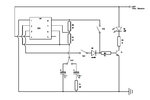Negativ3s
Newbie level 3

Hi forumers!
I have this cct that triggers the input to a counter/timer at frequency set by C1 & c2/R1 and SW3. Can someone explain to a noob HOW this thing works?
The circuit triggers by pushing momentary switch SW1, and provides continuous pulses. Momentary switch SW2 provides a single pulse.
Thanks a lot.